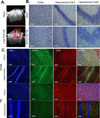Microwave & Magnetic (M2) Proteomics of a Mouse Model of Mild Traumatic Brain Injury
- PMID: 26157646
- PMCID: PMC4492171
- DOI: 10.1016/j.trprot.2014.03.002
Microwave & Magnetic (M2) Proteomics of a Mouse Model of Mild Traumatic Brain Injury
Abstract
Short-term increases in oxidative stress and decreases in motor function, including debilitating effects on balance and motor control, can occur following primary mild traumatic brain injuries (mTBI). However, the long-term effects on motor unit impairment and integrity as well as the molecular mechanisms underlying secondary injuries are poorly understood. We hypothesized that changes in central nervous system-specific protein (CSP) expression might correlate to these long-term effects. To test our hypothesis, we longitudinally assessed a closed-skull mTBI mouse model, vs. sham control, at 1, 7, 30, and 120 days post-injury. Motor impairment was determined by rotarod and grip strength performance measures, while motor unit integrity was determined using electromyography. Relative protein expression was determined by microwave & magnetic (M2) proteomics of ipsilateral brain tissue, as previously described. Isoprostane measurements were performed to confirm a primary oxidative stress response. Decoding the relative expression of 476 ± 56 top-ranked proteins for each specimen revealed statistically significant changes in the expression of two well-known CSPs at 1, 7 and 30 days post-injury: P < 0.001 for myelin basic protein (MBP) and P < 0.05 for myelin associated glycoprotein (MAG). This was confirmed by Western blot. Moreover, MAG, αII-spectrin (SPNA2) and neurofilament light (NEFL) expression at 30 days post-injury were directly related to grip strength (P < 0.05). While higher-powered studies of larger cohorts merit further investigation, this study supports the proof-of-concept that M2 proteomics is a rapid method to quantify putative protein biomarkers and therapeutic targets of mTBI and suggests the feasibility of CSP expression correlations to long-term effects on motor impairment.
Keywords: MAG; MBP; biomarkers; central nervous system-specific protein; magnetic; microwave; mild traumatic brain injury; motor impairment; proteins; proteomics.
Conflict of interest statement
The authors have no conflicts of interest to report.
Figures








References
-
- Dankers AC, et al. Hyperuricemia influences tryptophan metabolism via inhibition of multidrug resistance protein 4 (MRP4) and breast cancer resistance protein (BCRP) Biochim Biophys Acta. 2013;1832(10):1715–1722. - PubMed
-
- Coronado VG, et al. Trends in Traumatic Brain Injury in the U.S. and the public health response: 1995–2009. J Safety Res. 2012;43(4):299–307. - PubMed
-
- Fischer H. U.S. Military Casualty Statistics: Operation New Dawn, Operation Iraqi Freedom, and Operation Enduring Freedom. Congressional Research Service. 2010 http://www.crs.gov.
-
- Logan BW, et al. Concussive Brain Injury in the Military: September 2001 to the Present. Behav Sci Law. 2013 - PubMed
Grants and funding
LinkOut - more resources
Full Text Sources
Other Literature Sources
Research Materials
Miscellaneous
